Mexico, the U.S. and Indiana: Economy and Trade
Mexico is inextricably linked to the United States— politically, geographically and economically. The expanding Mexican economy is a large market for U.S. goods. Mexico's population is estimated at about 115 million people, roughly a third the size of the U.S. population.1 As Table 1 shows, Mexico lags the United States considerably in terms of its developed status. In 2011, Mexico received a United Nations Human Development Index ranking of 57, placing it between Saudi Arabia and Panama. The per capita income is also well below the U.S. average, nearly $30,000 below in purchasing power parity (PPP) dollars. Despite the lower standard of living, however, life expectancy in Mexico is about the same as the United States.
Table 1: Development Statistics for Mexico and the United States
| Human Development Index Measures | Mexico | United States |
|---|---|---|
| Human Development Index Value | 57 | 4 |
| Life Expectancy at Birth (years) | 77 | 78.5 |
| Education Index | 0.726 | 0.939 |
| Gross National Income per Capita (PPP U.S. dollars) | $13,245 | $43,017 |
Source: Human Development Reports, 2011
Economy
As Figure 1 shows, Mexico's economic growth has exceeded the U.S. rate of growth in every year since 2004, with the exception of 2009 when Mexico suffered considerable economic decline due to the worldwide economic slowdown. In 2010, economic growth bounced back, reaching nearly 6 percent. At $1.66 trillion in 2011, Mexico's economy is the 12th largest in the world.2
Even though its economy is relatively large, the World Bank ranked Mexico 53rd in 2012 among all nations in ease of doing business in terms of regulatory environment—right between St. Lucia and Botswana. More specifically, Mexico ranked 75th in ease of starting a business, 109th in terms of the tax burden, 81st in enforcement of contracts, and 142nd in ease of getting electricity. The regulatory environment has been, and continues to be, a major impediment to economic growth.3
Figure 1: GDP Growth for Mexico, the United States and the World, 2001 to 2010
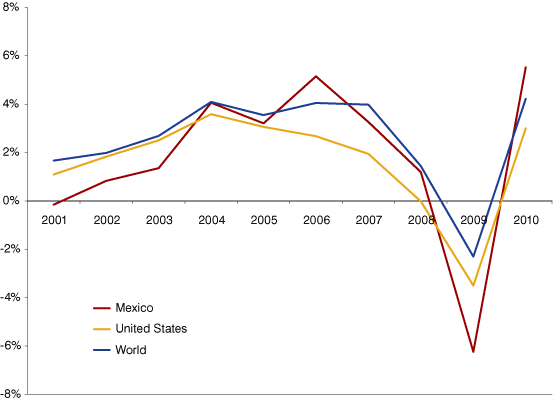
Source: IBRC, using World Bank data
Trade
As Figure 2 shows, Mexico has one major trading partner: the United States. Mexico's exports totaled $309.6 billion in 2010—74 percent of which were U.S. purchases. Rounding out the top five export destinations were Canada, China, Germany and Columbia. The remaining 14 percent of exports were fairly evenly split among many different nations in Central and South America, Europe, and Asia. Mexico's exports, like its overall economy, suffered a severe setback in 2009, but bounced back in 2010 to reach new heights. Between 2006 and 2010, Mexico's exports grew almost 25 percent.
Figure 2: Destinations of Mexican Exports, 2010
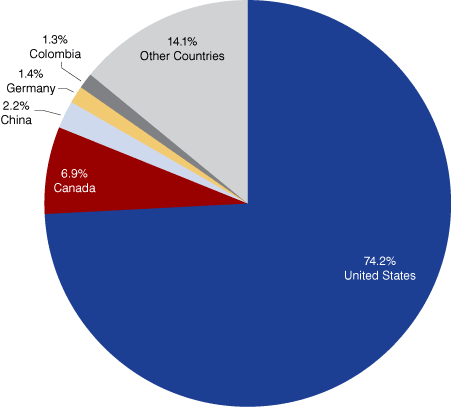
Source: IBRC, using WISERTrade data
Over the past few years, Mexico has exported more to the United States than the United States has to Mexico. This gap narrowed considerably in 2009 but widened again in 2010. As of 2010, U.S. exports to Mexico totaled $163 billion, whereas Mexican exports to the United States totaled $230 billion—a difference of $67 billion. Figure 3 shows the top 10 states exporting to Mexico over the last three years. Sharing a border with Mexico and the size of a state's overall economy play a large role in determining the volume of exports to Mexico. Texas is far-and-away the leader in exports to Mexico and has seen substantial growth in these exports over the last three years—from $56 billion in 2009 to $87 billion in 2011. California sits at a distant second, with 2011 exports to Mexico totaling $26 billion. The distribution widens considerably from there, with Michigan, Illinois and Arizona rounding out the top five. Indiana is the ninth-largest exporter to Mexico among the 50 states.
Figure 3: Top 10 States Exporting to Mexico, 2009 to 2011
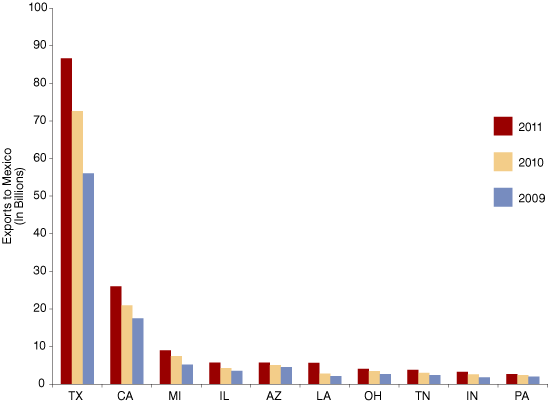
Source: IBRC, using WISERTrade data
Indiana's exports to Mexico topped $3 billion in 2011. As Figure 4 shows, nearly a third of those exports consisted of transportation equipment. Exports to Mexico in this industry have grown considerably over the past three years, rebounding from the significant dip the industry took as a whole in the middle of the last decade. The other major industries exporting to Mexico from Indiana show a strong focus on heavy manufacturing and chemical manufacturing, consistent with Indiana's overall export profile. Interestingly, chemical manufacturing exports, while still hovering around a quarter of a billion dollars, have declined over the last few years.
Figure 4 : Top Five Industries Exporting to Mexico from Indiana, 2009 to 2011
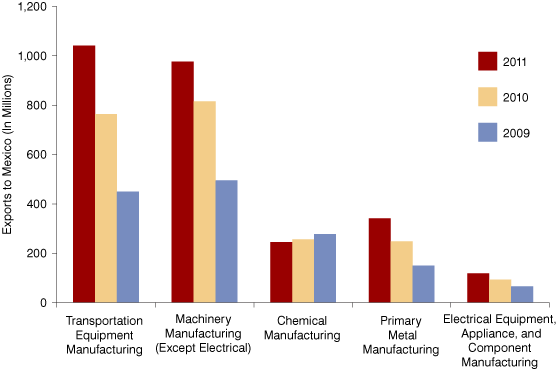
Source: IBRC, using WISERTrade data
While the trade gap between the United States and Mexico is fairly wide, the gap between Indiana and Mexico is much smaller. Indiana exported $3.3 billion in products and services to Mexico in 2011 while purchasing $3.6 billion in products and services. Figure 5 shows the top five industries exporting to Indiana from Mexico. As one might expect, the data show evidence of the exchange in auto parts (and components) between the two trading partners. Both are key players in automobile manufacturing, and transportation equipment leads all other industries in Mexico's exports to Indiana. Computer and electronics products are a strong second, although this industry's exports to Indiana have decreased over the last three years. As with Indiana's exports, Mexico's exports to Indiana tend to be heavy manufacturing.
Figure 5: Top Five Industries Exporting from Mexico to Indiana, 2009 to 2011
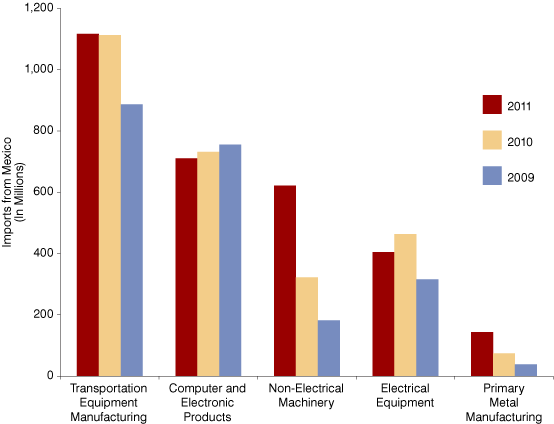
Source: IBRC, using WISERTrade data
Conclusion
Often the news coming from Mexico and about the U.S. relation with Mexico distracts from Mexico's importance as a trading partner. Despite arguments over immigration between Mexico and the United States—both legal and illegal—that may surface in U.S. political discourse,4 the ongoing drug-motivated violence,5 and the recent New York Times report revealing that Walmart had engaged in a systematic bribery program to secure building permits for new stores,6 Mexico will remain an important trading partner for the Hoosier state.
In 2011, Mexico represented the United States' second-largest trading partner (after Canada), accounting for roughly 13 percent of total U.S. exports. The United States, on the other hand, represented Mexico's largest trading partner, accounting for nearly three-fourths of Mexico's total exports.7 As such, it is clear that the United States and Mexico are as intricately linked economically as they are geographically. That said, it is also clear that Mexico is more dependent on the United States than vice versa. That could change, however, if Mexico pursued more pro-growth policies, for example, simplifying its regulatory system and fostering a more friendly business environment. To the degree that Mexico can create and expand its own businesses and can attract new business from other countries, its current dependence on the United States will moderate.
Notes
- Central Intelligence Agency, "Mexico," The World Factbook, https://www.cia.gov/the-world-factbook/countries/mexico/.
- Central Intelligence Agency, "Country Comparison: GDP (Purchasing Power Parity)," https://www.cia.gov/the-world-factbook/field/real-gdp-purchasing-power-parity/country-comparison.
- "Ease of Doing Business in Mexico," Doing Business: Measuring Business Regulations, http://doingbusiness.org/data/exploreeconomies/mexico.
- Padmananda Rama, "Immigration Debate Arrives at Supreme Court amid a Multitude of Voices," It's All Politics Blog, 25 April 2012, www.npr.org/blogs/itsallpolitics/2012/04/25/151359546/immigration-debate-arrives-at-supreme-court-and-with-it-a-multitude-of-voices.
- Reuters, "Twelve Decapitated near Guadalajara, Drug Gang Suspected," 9 May 2012.
- David Barstow, "Vast Mexico Bribery Case Hushed Up by Wal-Mart After Top-Level Struggle," New York Times, 21 April 2012, www.nytimes.com/2012/04/22/business/at-wal-mart-in-mexico-a-bribe-inquiry-silenced.html?_r=1.
- Source: https://wisertrade.org.
Ryan Krause
Research Associate, Indiana Business Research Center, Indiana University Kelley School of Business
